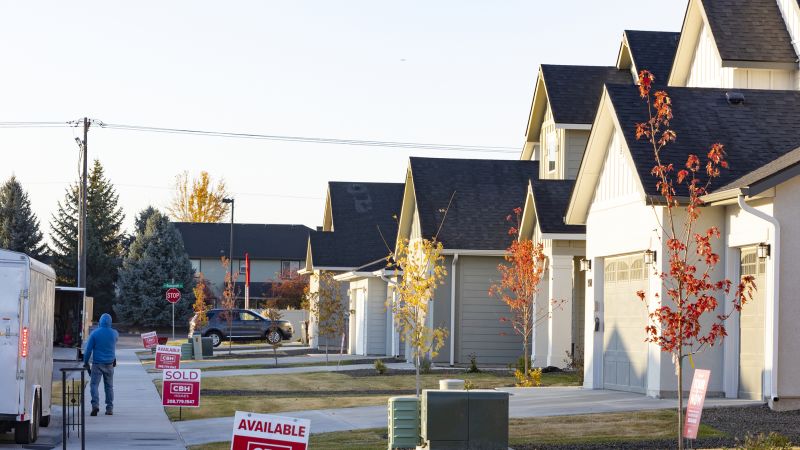Washington
CNN
—
Prior to the pandemic, Yue and Chris Parsons were, like many Millennials, reluctant renters moving from one apartment to another, wondering when they would be able to buy a home of their own.
But the pandemic turned out to be an opportunity — not just for the Parsonses, who are 34 and 36 years old, respectively, but for lots of other young people.
From 2016 to 2022, homeownership rates rose most for those under 44, according to recent analysis from the US Census, and much of that came during the pandemic period.
The Parsonses, who live in New York City, saw their prospects of buying a home improve during the pandemic as several factors came together: people left the city; the demand to buy a home dropped, cutting their competition; sellers were very motivated to get rid of apartments they could not longer afford; and mortgage rates dropped to historic lows.
“We were in this apartment on Sixth Avenue that was 650 square feet for two of us and a cat,” said Yue Parsons. “The walls were closing in on us. We could see apartments with outdoor space, and we were super jealous. We had time on our hands — so we began to look for a place to buy.”
They looked for something they could grow into, and found a two-bedroom, two-bathroom condo in the Hell’s Kitchen neighborhood of Manhattan. The owner had to sell quickly and was incredibly motivated, accepting their offer of $1.19 million for a property listed at $1.25 million.
They closed on their home in December 2020 and soon became the source of real estate envy: locking in a 2.875% interest rate on their 30-year, fixed-rate mortgage.
In addition to their ultra-low mortgage rate — which would likely be traded for a rate that is 6% or higher now, were they to buy something — Parsons said they couldn’t now afford comparable properties.
“Markets move and no one is really able to time the market,” said Parsons. “But we were at the right moment in our life to buy. We’re really happy. I think we’re never leaving.”
The homeownership rate grew overall during the pandemic, but it was fueled by younger people like the Parsonses buying a home, according to the Census Bureau.
Younger households are typically more likely to rent than own their home. But between 2016 to 2022, homeownership rates went up among adults under age 55, but stayed the same among those over 55.
The term “homeownership rate” can be misleading. It isn’t the percentage of people in the United States who own homes. Rather, the homeownership rate measures the percentage of all occupied housing owned by the occupants, as opposed to occupied by renters.
By 2022, the US homeownership rate was 65.8%, up from 64.6% in 2019. That rebound was driven largely by buyers who were aged 44 and younger, according to the Census Bureau’s Current Population Survey/Housing Vacancy Survey, released in July.
Homeownership rates dipped as low as 63.4% following the foreclosure crisis that began in 2004 and the Great Recession that began in 2008. But even the frenzy of homebuying during the peak pandemic years did not return the homeownership rate to its prior levels. Homeownership rates have recovered just half of the 5.6% drop in homeownership between 2004 and 2016.
Since data collection was interrupted by the pandemic in 2020, the Census Bureau said it cannot definitively determine how the homeownership rate changed for each year of the pandemic. But to track the metric’s movement, analysts looked at how the rate changed from its low in 2016 to the pre-pandemic rate in 2019, and the rate in 2022, when data collection returned to normal.
The Census data is also not able to determine reasons for this boost, but other research on the pandemic period has suggested that even with higher home prices, low interest rates enticed many people who were sitting on the fence into becoming home owners. In addition, other reasons for a boom in homebuying during the pandemic included a very strong stock market and migration from very expensive areas like San Francisco or New York to more affordable areas like Austin, Texas; Miami and Phoenix due to remote work.
Between 2016 and 2019, the homeownership rate increased for buyers under 55, according to the Census Bureau. But rates of homeownership remained stable among older householders 55 and older.
Growth was bigger for the younger groups between 2016 and 2022. The rate went up 4.5 percentage points for people 35 and younger and up 3.6 percentage points for people 35 to 44 years old, while it went up less than 1% for groups 55 to 65 years old and those 65 years old and older.
Still, even after the growth in homeownership by young people, the rate remains much greater among older Americans. While the rate for people 55 to 64 years old is 75% and of those 65 years and older it is 79%, the rate for those 35 to 44 years old is 62% and for those less than 35 is 39%.
Homeownership rates are growing for young people — and that should be celebrated — said Jessica Lautz, deputy chief economist at the National Association of Realtors, during an economic summit last week. But, historically, rates of homeownership for young people have been even higher.
The average age of a first-time home buyer is now 36 years old, according to NAR. That is the same average age as a repeat buyer in 1981. The current age of a repeat buyer today is 59 years old.
“That is a dramatic shift,” said Lautz. “That is a lot of lost housing wealth for these young adults. And that 59-year-old buyer is going to need and want different things out of their home than what we had traditionally seen for that 36-year-old [repeat buyer].”
There is a sizable population between 26 and 32, said Lautz. “When you think about housing starts and household formation, these young adults are going to want that place to live that’s not necessarily with a roommate or with their family, they are going to want their own place.”
But there are still a lot of young buyers out there who want to find their own homes, she said.
“They need to learn about all the opportunities for buyers to get into a home, including FHA loans, VA loans, low down payment programs,” she said. “We can bring these home buyers to the table, as long as we have the inventory to support it.”
Sumber: www.cnn.com






